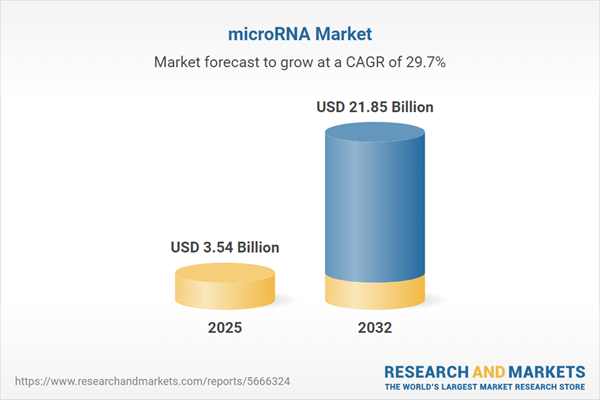Speak directly to the analyst to clarify any post sales queries you may have.
The microRNA market is rapidly transforming due to breakthroughs in gene expression research, regulatory developments, and dynamic shifts in global supply chains. This report provides critical intelligence for executive decision-makers seeking actionable insights and a clear, strategic overview of a complex, evolving field.
Market Snapshot: microRNA Market Size and Growth
The microRNA market grew from USD 2.72 billion in 2024 to USD 3.54 billion in 2025, with a compound annual growth rate (CAGR) of 29.72%. By 2032, the market size is projected to reach USD 21.85 billion, highlighting expanding opportunities for innovative solutions and strategic advancement.
Scope & Segmentation
This report comprehensively analyzes the microRNA market, delivering coverage across product innovations, applications, and end-user dynamics by region and technology. Segments addressed include:
- Product Type: Instruments, Kits & Reagents, Software & Services
- Instruments: Microarray Systems, qPCR Systems, Sequencing Systems
- Kits & Reagents: Detection Kits, Extraction Kits, Library Prep Kits, Profiling Kits
- Software & Services: Bioinformatics Services, Consultation Services, Data Analysis Software
- Application: Basic Research, Diagnostics, Drug Discovery & Development
- Basic Research: Functional Genomics, Gene Expression Profiling
- Diagnostics: Cancer Diagnostics, Cardiovascular Diagnostics, Infectious Disease Diagnostics
- Drug Discovery & Development: Biomarker Discovery, Target Validation, Toxicology Studies
- End User: Academic & Research Institutes, Contract Research Organizations, Diagnostic Laboratories, Pharmaceutical & Biotechnology Companies
- Regions: Americas (North & Latin America), Europe, Middle East & Africa, Asia-Pacific
Coverage extends to leading market participants including Thermo Fisher Scientific Inc., QIAGEN N.V., Illumina, Inc., Agilent Technologies, F. Hoffmann-La Roche Ltd., Bio-Rad Laboratories, Merck KGaA, Promega Corporation, NanoString Technologies, and Takara Bio Inc.
Key Takeaways for Senior Decision-Makers
- microRNA technologies underpin a wide array of applications, driving advances in diagnostics, functional genomics, and therapeutic development.
- Industry leaders are leveraging integrated product platforms, offering streamlined workflows that enhance research productivity and clinical accuracy.
- Next-generation sequencing protocols, coupled with advanced bioinformatics, enable detailed microRNA profiling, supporting dependable data interpretation and biomarker identification.
- The supply chain landscape is adapting to regulatory shifts, with new logistics models and regional production strategies supporting global research continuity.
- Strategic collaborations are increasing among technology developers, CROs, and biopharma firms, accelerating translation from discovery to clinical deployment.
- Segment diversity across geography and end user necessitates tailored market approaches to effectively address emerging regulatory, procedural, and cost management challenges.
Tariff Impact: Focus on 2025 U.S. Tariffs
Tariff measures introduced by the United States in 2025 have shaped procurement and supply chain decisions within the microRNA sector. Increased costs for high-precision sequencing systems and reagents have prompted manufacturers and laboratories to pursue alternative sourcing routes and localized production. Regional warehousing and co-development initiatives in tariff-exempt areas are fostering greater market resilience and operational flexibility. While these shifts present short-term pressures, they are contributing to stronger, more agile supply chains, ensuring consistent research and commercial operations across global markets.
Methodology & Data Sources
This analysis employs a multi-stage research approach that includes a thorough review of scientific literature, patent databases, regulatory filings, and corporate disclosures. Insights were validated via interviews with domain experts from academic, clinical, and industry backgrounds. Proprietary surveys further inform product and workflow trend analysis. Results were cross-checked and reviewed by subject matter experts for accuracy and depth.
Why This Report Matters
- Enables strategic planning by identifying drivers and barriers in the evolving microRNA market ecosystem.
- Arms decision-makers with actionable segmentation and regional intelligence to support investment, R&D, and supply chain optimization.
- Supports risk mitigation and opportunity identification in response to regulatory, competitive, and technological market shifts.
Conclusion
This report provides a holistic and actionable assessment of microRNA market dynamics, delivering clarity on technology trajectories and partnership opportunities. Stakeholders are equipped to make informed, confident decisions in this dynamic sector.
Additional Product Information:
- Purchase of this report includes 1 year online access with quarterly updates.
- This report can be updated on request. Please contact our Customer Experience team using the Ask a Question widget on our website.
Table of Contents
3. Executive Summary
4. Market Overview
7. Cumulative Impact of Artificial Intelligence 2025
Companies Mentioned
The companies profiled in this microRNA market report include:- Thermo Fisher Scientific Inc.
- QIAGEN N.V.
- Illumina, Inc.
- Agilent Technologies, Inc.
- F. Hoffmann-La Roche Ltd.
- Bio-Rad Laboratories, Inc.
- Merck KGaA
- Promega Corporation
- NanoString Technologies, Inc.
- Takara Bio Inc.
Table Information
| Report Attribute | Details |
|---|---|
| No. of Pages | 197 |
| Published | October 2025 |
| Forecast Period | 2025 - 2032 |
| Estimated Market Value ( USD | $ 3.54 Billion |
| Forecasted Market Value ( USD | $ 21.85 Billion |
| Compound Annual Growth Rate | 29.7% |
| Regions Covered | Global |
| No. of Companies Mentioned | 11 |









